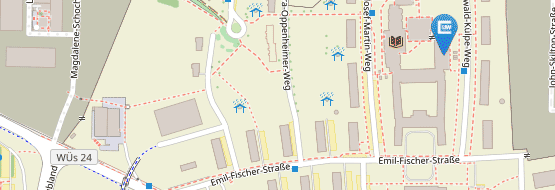History of principals and presidents
The long tradition of university presidents in seven parts
Although the president of a university no longer has princely rights, every change of leadership changes the direction of the university. The political course is adjusted and new paths are taken; the personality of the president also always shapes the face of a university, even if the structures within it may not undergo a major overhaul. But since when has the office of president existed in Würzburg at all? Who used to head the university? How was the office assigned, did the university community have a say? Or did the sovereign determine the fate of the university? The University Archives dealt with such questions on the occasion of the current change of office on April 1, 2021, and went in search of traces in a history of over 600 years.
The head of the Würzburg University in the Middle Ages
Part 1 of 7
Today, the organization and tasks of the university rest on a legal basis of state higher education laws and the university's own basic regulations. In earlier times, privileges and statutes formed the basis of the university, because since time immemorial it was recognized that there was a need for uniform regulation with regard to the organization and conduct of the individual university bodies, which is why there is evidence of several statutes of other universities in medieval times.
The statutes of the university founded by Bishop Johann von Egloffstein have not survived. The founding privilege issued by Pope Boniface IX in Rome on 10 December 1402 does not contain any organizational regulations and refers to the University of Bologna as a model.
Students from all over Europe came to Bologna, the oldest European university, to study law. To protect themselves from xenophobic attacks, in the 12th century they joined together with other students of the same regional origin and employed teachers (professors) to instruct them. The various associations united to form the university and sent representatives to a council that elected a student rector and conducted negotiations with the professors. The professors also united to form colleges of doctors, but in Bologna they were not part of the university.
Bologna and Paris
Bologna became a model for the student universities of Southern Europe, but for Würzburg, despite the explicit mention in the founding privilege, no undoubted model function can be assumed. In contrast to Bologna, where there were initially only law studies and thus no faculties, the Würzburg founding privilege provides for the establishment of faculties. Here, the example of the second model university, the University of Paris, which was founded almost at the same time as Bologna, is significant. The University of Paris also had the nations that characterized medieval universities, but it was also divided into four faculties: artes liberales, theology, jurisprudence (canon law only), and medicine. The rector was elected by the magisters of the artes faculty from their ranks. For the German universities, the University of Prague, which had adopted various elements from Bologna and Paris, also had a formative effect. While in Bologna the rector was elected by students from the student body, in mixed constitutions, as in Prague, it was common for students and magisters to elect a representative together. For Würzburg, the known names of the rectors prove that not students but clergymen, either members of the cathedral chapter or professors of theology, were elected.
Würzburges specialties
In Italian universities, the rector possessed extensive rights with regard to general decisions, jurisdiction and financial management; in central and northern Europe, these powers were often limited by a chancellor. The chancellor was usually the local bishop, who, as the institution's sponsor, thereby retained control. In Würzburg, the bishop or his vicar thus determined teaching permission at the university. The known statutes of other universities give an impression of the organization of the medieval universities. However, since even in clear filiations new statutes could deviate greatly from their models, the Würzburg constitution cannot be reconstructed from these.
The lesser known principals from the founding phase
The names of the rectors from this period are known: Albrecht von Heßberg, Günther von der Kere, Paul von der Kere and Peter von Treysa. The last known and only rector of the University of Würzburg mentioned by Lorenz Fries in his chronicle from 1410 was the canon and law student Johannes Zantfurt. In 1412, he moved into one of the university buildings, the Hof zum Großen Löwen in today's Dominikanergasse. There he was murdered by his servant for unknown reasons just three years after taking office, on December 1, 1413.
Decline of the university
The continuation of the university after the death of its founder and supporter in 1411 became increasingly difficult due to insufficient material and financial resources. At an unknown time after the last documented appointment of professors in 1427, teaching ceased. Legally, however, the university continued to exist. Unfortunately, there is no evidence of a university seal, but the rector's seal survived the centuries and could be reconstructed on the basis of the slightly damaged imprint on a document issued by the rector on October 2, 1410. In this document, both teachers and students undertook to observe the privileges granted by Bishop John.
For the next 150 years or so, the university sank into a slumber, but without being completely forgotten.






